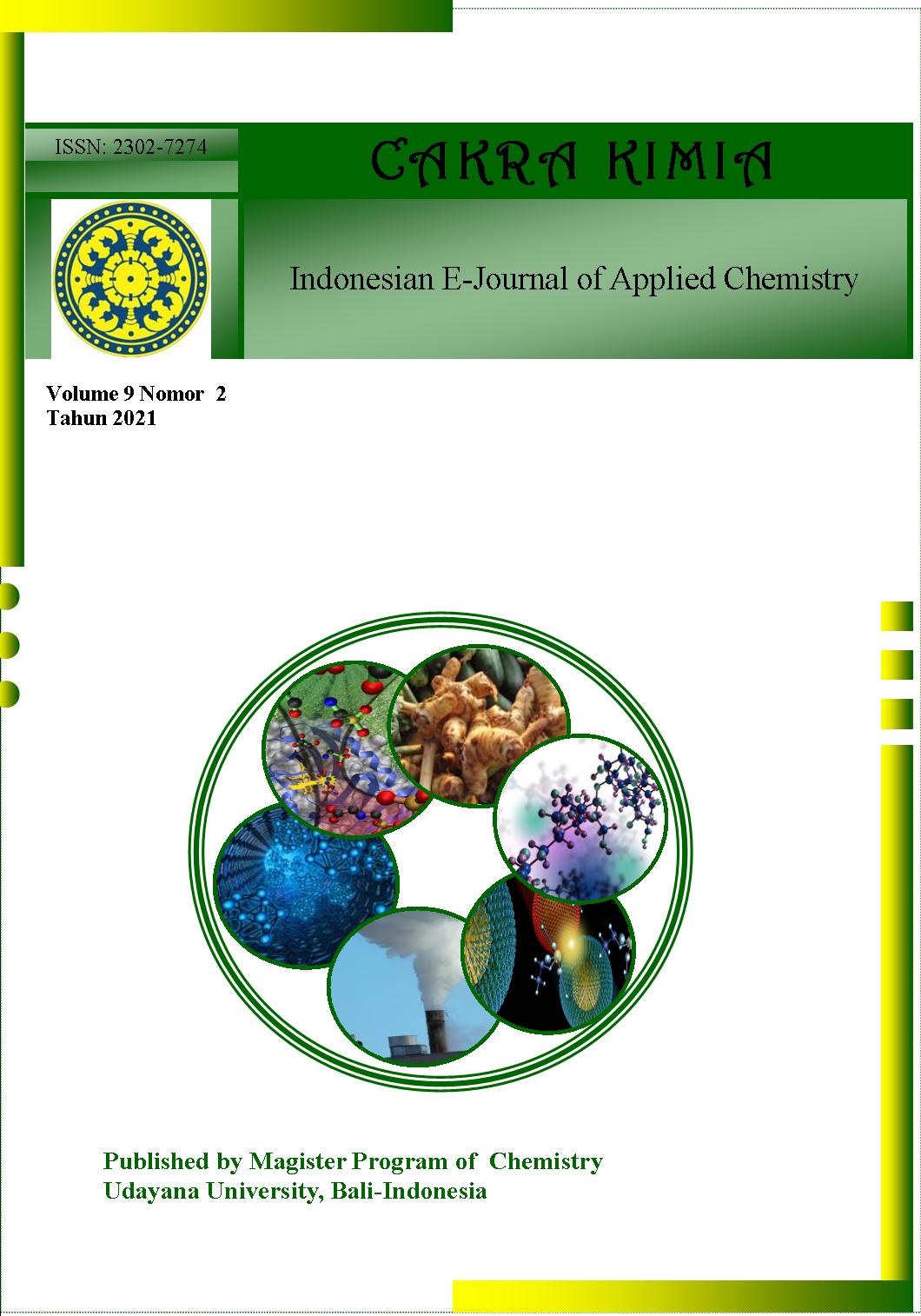UJI AKTIVITAS EKSTRAK METANOL DAUN KEBIUL (Caesalpinia bonduc L.) SEBAGAI BAHAN AKTIF SEDIAAN TABIR SURYA
Abstract
ABSTRAK: Penelitian ini bertujuan untuk menentukan aktivitas tabir surya dari nilai SPF (Sun Protection Factor) Aktivitas tabir surya ditentukan dengan Penentuan SPF dilakukan dengan metode Spektrofotometri Uv-Vis. Kandungan senyawa kimia ditentkan dengan uji fitokimia. Hasil penelitian menunjukkan bahwa nilai SPF yang diperoleh dari konsentrasi 200, 400, 600, 800, dan 1000 ppm berturut-turut yaitu sebesar 2,4 (proteksi minimal); 4,7 (proteksi sedang); 7,8 (proteksi ekstra); 9,2 (proteksi maksimal) dan 11,3 (proteksi maksimal). Berdasarkan uji fitokimia, ekstrak metanol daun kebiul positif mengandung flavonoid, tanin, steroid, dan saponin.
ABSTRACT: This study aims to determine the activity of sunscreen from the value of SPF (Sun Protection Factor). Sunscreen activity was determined by determining the SPF using the Uv-Vis Spectrophotometry method. The content of chemical compounds is determined by phytochemical tests. The results showed that the SPF values obtained from concentrations of 200, 400, 600, 800, and 1000 ppm were 2.4 (minimum protection); 4.7 (moderate protection); 7.8 (extra protection); 9.2 (maximum protection) and 11.3 (maximum protection). Based on the phytochemical test, the methanol extract of kebiul leaves was positive for flavonoids, tannins, steroids, and saponins
Downloads
References
[2] Matts, P.J. 2006. Solar ultraviolet radiation: definitions and terminology. Dermatologic clinics: 24 (1): 1-8.
[3] Wang, S.Q. Stanfield, J.W. and Osterwalder, U. 2008. In Vitro Assessment of UV A Protection by Populer Sunscreen Available in The United States, J. Am. Dermatology. 59(6): 934-42.
[4] Tranggono, R.I. dan Latifah F. 2007, Buku Pegangan Ilmu Pengetahuan Kosmetik, Jakarta: PT. Gramedia Pustaka: 12: 26-30, 48, 81-86.
[5] Laporan Nasional RISKESDAS 2018. Badan Penelitian dan Pengembangan Kesehatan Kementerian Kesehatan RI.
[6] Wilkinson, J. B. dan Moore, R. J., 1984, Harry’s Cosmeticology, 7th Ed., Chemical Publishing Company, 223-224, 236.
[7] Sahasrabuddhe, H.S. 2011. Lycopene: an antioxidant. Pharma Times, 43 (12): 13-14.
[8] Rai, R., Shanmuga, S.C., and Srinivas, C. 2012. Update on Photoprotection. Indian Journal of Dermatology, 57(5): 335–342.
[9] Stanfield, J.W. 2010, Sun Protectans: Enhancing Product Functionality with Sunscreen, in Schueller, R. and Romanowski, P. Multifunctional Cosmetic, Marcell Dekker Inc, New York, USA.
[10] Garoli, D., Pelizzo, M.G., Nicolossi, P., Peserico, Tonin, E. and Alaibac, M. 2009. Effectiveness of different substrate materials for in vitro sunscreen test. J. of Dermatological Science, 56(2): 89-98.
[11] Brezova, V., Gabcova, S., Dvoranova, D., Stasko, A. 2005. Reactive Oxygen Spesies Produced Upon Photoexcitation of Sunscreens Containing Titanium. Dioxide (an EPR Study), Journal of Photochemistry and Photobiology B: Biology, 79: 121-134.
[12] Muryati, T. S. 2019. Pengembangan E- Modul KOBA Berbasis Penelitian Sintesis Nanopartikel Lemak Padat Minyak Sawit Merah Ekstrak Caesalpinia bonduc L Terhadap Penurunan Jumlah P . Berghei, Tesis, Fakultas Keguruan dan Ilmu Pendidikan Universitas Bengkulu.
[13] Ogunlana, O.O. Ogunlana, O.E., Ntube, C.A., Olagunju, J.A., and Akindahunsi, A.A. 2012. Phytochemical Screening and in vivo antioxidant activity of Ethanolic extract of Caesalpinia bondus (L.) Roxb. Global R J Pharm Sci., 1(1): 1-4.
[14] Walters, C. Keeney, A., Wigal, C.T., Johnston, C.R., and Cornelius, R.D. 1977. The Spectrophotometric Analysis and modeling of sunscreens. J. Chem. Educ. 74(1): 99-109.
[15] Purwati, S., Lumora, S.V.T., dan Samsurianto, 2017. Skrining Fitokimia Daun Saliara (Lantara camara L) sebagai Pestisida Nabati Penekan Hama dan Insidensi Penyakit Pada Tanaman Holtikultura di Kalimantan Timur” Prosiding Seminar Nasional Kimia: 153-158.
[16] Asmara, A. P. 2017. Uji Fitokimia Senyawa Metabolit Sekunder Dalam Ekstrak Metanol Bunga Turi Merah (Sesbania grandiflora L. Pers), Al-Kimia, 5 (1): 48-59.
[17] Tetti, M. 2014. Ekstraksi, pemisahan Senyawa, dan Identifikasi Senyawa Aktif. Jurnal Kesehatan. 7(2): 361-367.
[18] Astarina. N.W.G., Astuti, K.W. Warditiani, N. K. 2013. Skrining Fitokimia Ekstrak Metanol Rimpang Bangle (Zingiber purpureum roxb.). Jurnal Farmasi Udayana, 2(4): 1-6.
[19] Kristanti, A. N., Aminah, N. S. Tanjung, M. dan Kurniadi. B. 2008. Buku Ajar Fitokimia. Airlangga University Press.Surabaya: Hal. 23, 47.
[20] Shovyana, H.H., & Zulkarnain, A.K. 2013. Stabilitas Fisik dan Aktivitas Krim W/O Ekstrak Etanolik Buah Mahkota Dewa (Phaleria macrocarpha) Sebagai Tabir Surya. Trad. Med. J., 18(2): 109-117.
[21] More, B.H., Sakharwade, S., Thembrune S., and Sakarkar D. 2013. Evaluation of Sunscreen Activity of Cream Containing Leaves Extract of Butea monosperma for Topical Application. International Journal of Research in Cosmetic Science, 3(1): 1-6.
[22] Draelos, Z.D. and Thaman, L.A. 2006, Cosmetic Formulation of Skin Care Products, Volume 2. Taylor and Francis Group, New York. 157-159.
[23] Daun, N.S., La Ode, Z.A.H., dan Ervianingsih. 2016. Formulasi Lotion Tabir Surya Ekstrak Etanol Beras Merah. Kendari, Jurnal Ilmiah
Ibnu Sina, 1(2), 143-150.
[24] Svobodová, A., Psotová, J., and Walterová. D. 2004. Natural phenolic inthe prevention of UV-induced skin damage, a review. J. Biomed. Papers, 147 (2):137-145.
[25] Hagerman, A.E., Riedl, K.M., Jones, G.A., Sovik, K.N., Ritchard, N.T., Hartzfeld, P.W., and Riechel, T.L. 1998. High molecular weight plant polyphenolics (tannins) as biological antioxidants. J. of Agricultural and Food Chemistry, 46(5): 1887-1892.
[26] Prasiddha, I. J., Laellocattleya, RA., Estiasih, T., Maligan, J.M. 2016. Potensi Senyawa Bioaktif Rambut Jagung Untuk Tabir Surya Alami: KajianPustaka. Jurnal pangan dan argoindustri, 4(1): 40-45.



 Petunjuk Penulisan
Petunjuk Penulisan
